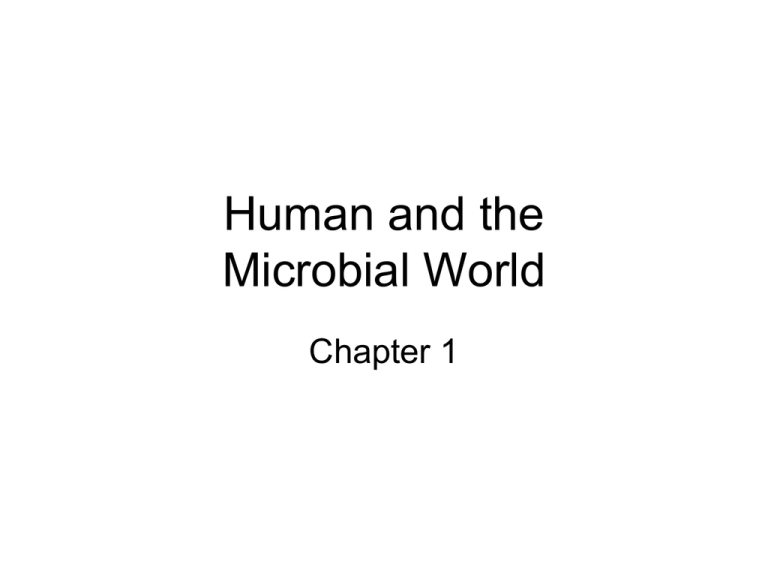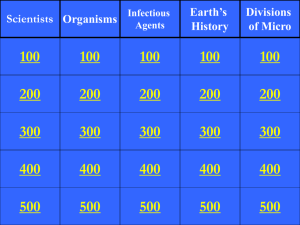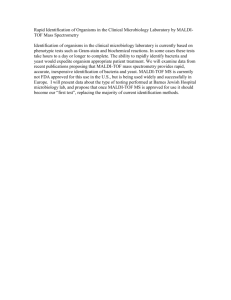Chapter 1
advertisement

Human and the Microbial World Chapter 1 Preview • History of microbiology – microscope, spontaneous generation • Applications of microorganism/microbiology – Bioremediation, disease treatment and prevention, genetic engineering, model system to study • Classification and nomenclature of microorganisms – Three domains and major characteristics – Binominal system Introduction • What is Microbiology? • Includes several sub-disciplines – Bacteriology - Virology – Mycology - Parasitology – Food microbiology – Environmental microbiology – Forensic microbiology Introduction • Microbiology born as a science in 1674 – Anthony van Leeuwenhoek • Dutch drapery merchant • First glimpses of microbial world – Called organisms “animalcules” – Robert Hook • Looked at cork The Origin of Life • Theory of Spontaneous Generation “Organisms can arise from decaying non-living organic matter” mice maggots People contributed to disproving the theory – Francesco Redi – Louis Pasteur – John Tyndall Francesco Redi • Demonstrated worms can not be spontaneously generated from rotten meat. – Covered with fine gauze – No eggs – no worms “spontaneous generation” Louis Pasteur • father of modern microbiology • Design swan neck bottle-proved that bacteria growth in the infusion was due to contamination from air John Tyndall • Explained discrepancies – Different infusions require different boiling time. – Suggest heat resistant form of life cause contamination. – German botanist Ferdinand Cohn discovered endospores in the same year – Robert Koch established endospore role in disease transmission Origin of Microorganism unsolved mystery What is spontaneous generation theory? Who were the scientists disproved it? How did they disproved it? Applications of Microorganism • Microbes have enormous impact on human existence – Responsible for the production and recycle of oxygen and nitrogen • Key elements for all living organisms – Decomposers • breakdown of wide variety of material Such as cellulose from plants Applications of Microorganism • Food production – Fermentation to produce numerous products • Bioremediation – Use organisms to degrade environmental waste • Degrade PCB’s, DDT • Clean up oil spills • Treat radioactive waste Applications of Microorganism • Bacteria can synthesize numerous products – Ethanol – Pesticides – Antibiotics – Dietary amino acids Applications of Microbiology • Genetic engineering – Definition: introduce genes of one organism into an unrelated organism to confer new properties on the organism • to produce medically important products and vaccines • Engineered plants resist disease • Potentially therapeutic – Gene therapy Application of Microbiology • Microorganisms are wonderful model for study – Metabolic and genetic properties similar to higher forms of life. – Building blocks of macromolecules same as other life forms – “What is true for an elephant is also true for a bacteria” – Much simpler system – High growth rate Applications of Microbiology • Better treatment and prevention of disease. – Microbes are important causes of morbidity and mortality • More people died worldwide of influenza in the 1918 epidemic than died in WWI, WWII, Korean War and Vietnam combined – Modern sanitation, vaccination and effective antimicrobial treatments have reduced incidence of the worst diseases Application of Microbiology •understanding how they cause disease can help prevent disease Per 100,000 Present and Future Challenges • Infectious disease remains a threat – 750 million cases each year in US • 200,000 deaths • Tens of billions of dollars spent on health care Present and Future Challenges • Emerging diseases – with increased occurrence and wider distribution • Seemingly new diseases • include – – – – – Mad cow disease AIDS West Nile virus disease Severe Acute Respiratory Syndrome (SARS) Swine flu • Factors associated with emerging disease – Changing lifestyles – Genetic changes in organisms Present and Future Challenges • Resurgence of old diseases – Diseases thought to be “defeated” increasing in frequency • Often more serious • usually resistant to treatment • Reasons for resurgence – Increased travel – Unvaccinated individuals susceptible to infection Present and Future Challenges • Chronic disease caused by bacteria – Many disease once thought caused by environmental stressors actually caused by bacteria • Example: gastric ulcers – Causative agent – Helicobacter pylori Host-Bacterial Interactions • Estimated 500 – 1000 species of bacteria reside in and on the human body • Bacteria out number cells in the body 10:1 • compete with other organisms for food and space – Keep disease causing organisms from breaching host defenses – Help digest food in intestine. • Some bacteria and viruses use the human body as a habitat for multiplication, persistence and transmission Classification Classification - process of arranging organisms into similar or related groups, primarily to provide easy identification and study •Domain - a collection of similar kingdoms •Kingdom - a collection of similar phyla or classes •Phylum/division - a collection of similar classes •Class - a collection of similar orders •Order - a collection of similar families •Family - a collection of similar genera •Genus - a collection of related species •Species - a group of related isolates or strains The Microbial World • All living things can be classified in three domains – Bacteria – Archaea – Eucarya • Organisms in each domain share certain properties The Microbial World • Bacteria and Archaea – single-celled organisms – Contain no membrane bound nucleus • Termed prokaryotes = pre nucleus – Pro = pre – karyote = nucleus – Do not contain any other organelles – Cytoplasm is surrounded by rigid cell wall Domain Bacteria • Most common type in human infection • Members widely diverse • Most prominent features include: – Specific shapes • Rod-shaped, spherical and spiral – Rigid cell walls • Responsible for cell shape – Multiply by binary fission • One cell divides into two • Each cells is genetically identical to the first – Some bacteria are motile • Move by means of flagella Domain Archaea • Demonstrate a number of same attributes as Bacteria – Same shapes – Multiply through binary fission – Move by means of flagellum • Archaea exhibit significant difference – Chemical composition of cell wall differs from organisms in other domain – Organisms of Archaea domain found in extreme environments • Extreme temperatures • Environments with high concentrations of salts Domain Eucarya • Eucarya – Organisms contain membrane bound nucleus • Termed eukaryote = true nucleus – Eu = true – karyote = nucleus – Contains internal organelles • Making organism more complex – Example = mitochondria • May be single or multicellular Domain Eucarya • Microbial world includes: – Algae – Fungi – protozoa Domain Eucarya • Algae – Usually found near surface waters – All contain chlorophyll • Pigments used to absorb light to be used as energy source – Some contain other pigments – Have rigid cell wall • Distinct from bacterial cell walls Domain Eucarya • Fungi – Diverse single celled and multicellular organisms • Single celled = yeast • Multicellular = molds – Gain energy from organic materials – Found mostly on land Domain Eucarya • Protozoa – Found in water and on land – Much larger than prokaryote – Do not have a rigid cell wall – Gain energy from organic matter – Most are motile • Means of motility diverse and a feature of their classification What is the major difference between bacteria and eukaria? Nomenclature • Binomial naming system – Two word naming system • First word is genus name – Always capitalized • Escherichia • Second word is species name – Not capitalized • coli • When writing full name genus usually abbreviated – E. coli • Full name always italicized – Or underlined Bacillus anthracis Bacillus cereus Bacillus anthracis Nomenclature Modern human Homo Sapiens Domestic dog Canis familiaris •Genus - a collection of related species •Species - a group of related isolates or strains Wolf Canis lupus Viruses, Viroids, Prions • Non-living elements (agents) – Not organisms – obligate intracellular parasites • Must have host machinery to replicate • Inactive outside of host Viruses, Viroids, Prions • Usually consist of only a few molecules found in living cells – protein coat surrounding nucleic acid • Essentially protein bag of nucleic acid • All forms of life can be infected by viruses • Viruses frequently kill host cells – Some live harmoniously with host Viruses, Viroids, Prions • Viroids are simpler than viruses – Still require host cell for replication • Consist of a single short piece of RNA – Contains no protective protein coat • Viroids smaller than viruses • Generally cause plant diseases Viruses, Viroids, Prions • Prions are infectious proteins – Contains no nucleic acid • Responsible for six neurodegenerative diseases • Scrapie in sheep • Mad cow disease in cattle • Kuru in human Size in the Microbial World • Tremendous range in size – Smallest virus approximately 1/1,000,000th size of largest eukaryotic cell Scientist found a microorganism that is 10um long. Which domain it belongs to?







